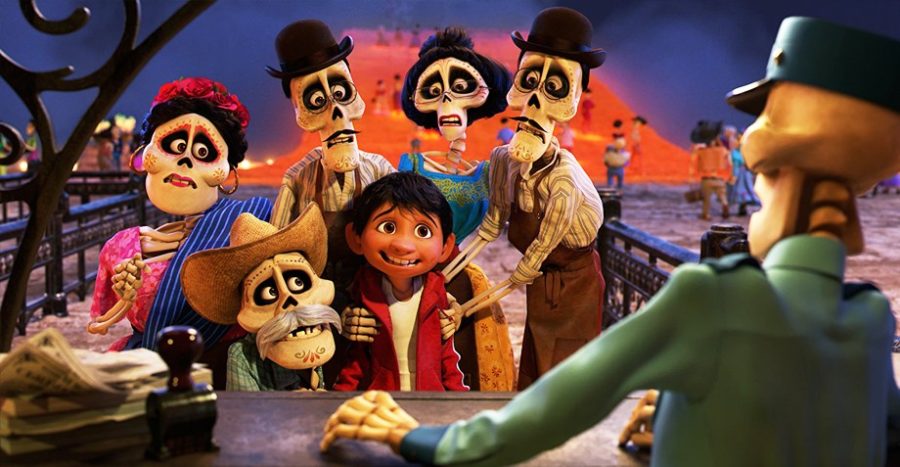Going Cuckoo For Coco
Pixar’s newest animated film “Coco” has been a success in theaters, grossing over $391.1 million at the box office and receiving an astounding 96% on Rotten Tomatoes. The film follows a 12-year-old Mexican boy named Miguel Rivera who has a deep passion for music, which is something that his family has strongly disapproved of for generations. He and a street dog named Danté embark on an extraordinary journey to the Land of the Dead on Día de Los Muertos. In the Land of the Dead, Miguel encounters his deceased relatives and realizes the importance of family, while also trying to solve the mystery regarding his family’s ban on music. This hilarious, tear-jerking, and vibrant movie is not only entertaining, but it is also a movie that holds cultural significance for many.
“Coco” is the first major Pixar movie that deals with Mexican culture as it takes place in Mexico and is accurate to Mexican life and tradition. The movie revolves around Día de Los Muertos, or Day of the Dead, which is a holiday in which families create altars, or ofrendas, for deceased loved ones decorated with food, objects, and photos. According to Mexican tradition, deceased loved ones can cross over into the physical world only on this day.
The movie’s music includes songs with Spanish lyrics such as “Un Poco Loco,” “La Llorona,” and “The World Es Mi Familia,” all of which were written by Robert Lopez and Kristen Anderson-Lopez, the songwriting team behind the “Frozen” soundtrack. Additionally, a majority of the characters’ dialogue includes Spanish phrases mixed in with the English language. Miguel’s multigenerational family all live in one home as a large family; this is very typical, and the film reflects how Mexicans value family and traditions in such high esteem. Miguel calls his family members “mamá,” “papá,” “tío,” “tía,” and “abuelita,” and although a small detail, it demonstrates Mexicans’ daily family interactions.
CHS senior Giselle Guillen watched the movie and takes extreme pride in her heritage and is honored her unique culture is finally being depicted with care and respect.
“I think Disney represented Mexican life so well,” Guillen said. “It was mostly in the small details that you wouldn’t really notice at first glance. The nicknames, the colorful houses, the crosses in the rooms are things you would see in Mexican lives. Even the infamous chancla made it into the movie, which definitely provided a good dose of humor. I wish that I had a movie that represented who I was and my culture when I was growing up, but I’m so glad that children today can go to the movies and see someone that looks and talks like them and their family. ‘Coco’ means a lot not just to me, but to all Mexicans and Mexican-Americans who have never really had representation in American media, and the fact our culture was portrayed so beautifully and so well is a dream come true.”
For most Mexicans, this is the first time that their culture is being represented in an animated movie. Wide recognition by mainstream media shows how Americans accept and appreciate many diverse cultures. In film and TV, Mexicans are often portrayed in a “comedic” light, sporting sombreros and big mustaches. Conversely, this film stays authentic to Mexican traditions.
Another CHS student was enthusiastic with the movie’s release.
“I believe that ‘Coco’ has opened doors for people around the world to learn more about Dia de Los Muertos and see a glimpse of our heritage and traditions,” CHS senior Collette Hernandez said. “I feel that it represented the Mexican community well as it emphasized the importance of family, and how the love we feel doesn’t go away even after death, something which we are taught at a young age to value and respect”
Pixar’s “Coco” has been enthusiastically received by critics and Mexicans alike. It is a movie that celebrates Mexico, appreciating it rather than exoticizing it. In the heat of political tensions between Mexico and the current U.S. President calling Mexicans “rapists” and “drug dealers,” “Coco” brings to light the integrity, culture, and strength of Mexicans and Mexican-Americans alike.
Image courtesy of sopitas.com
Hello there! Our goal is to provide relavent, engaging journalism for readers of all ages. Your donation will support the student journalists of the Wolfpacket at Claremont High School, and will allow us to purchase equipment, print our monthly issues, and enter in journalism competitions. We appreciate your consideration!

Paulina Gonzalez is currently a senior at Claremont High and it is her second year on the Wolfpacket. She is serving as the head Opinions editor and is...










